25.08.2017
NASA’s James Webb Space Telescope will use its infrared capabilities to study the “ocean worlds” of Jupiter’s moon Europa and Saturn’s moon Enceladus, adding to observations previously made by NASA’s Galileo and Cassini orbiters. The Webb telescope’s observations could also help guide future missions to the icy moons.
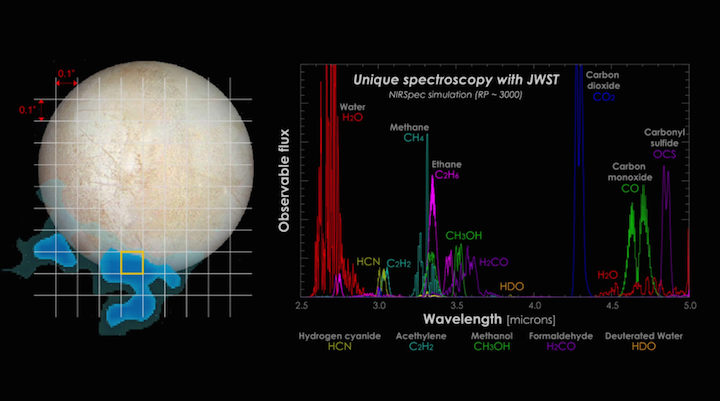
Europa and Enceladus are on the Webb telescope’s list of targets chosen by guaranteed time observers, scientists who helped develop the telescope and thus get to be among the first to use it to observe the universe. One of the telescope’s science goals is to study planets that could help shed light on the origins of life, but this does not just mean exoplanets; Webb will also help unravel the mysteries still held by objects in our own solar system (from Mars outward).
Geronimo Villanueva, a planetary scientist at NASA’s Goddard Space Flight Center in Greenbelt, Maryland, is the lead scientist on the Webb telescope’s observation of Europa and Enceladus. His team is part of a larger effort to study our solar system with the telescope, spearheaded by astronomer Heidi Hammel, the executive vice president of the Association of Universities for Research in Astronomy (AURA). NASA selected Hammel as an interdisciplinary scientist for Webb in 2002.
Of particular interest to the scientists are the plumes of water that breach the surface of Enceladus and Europa, and that contain a mixture of water vapor and simple organic chemicals. NASA’s Cassini-Huygens and Galileo missions, and NASA’s Hubble Space Telescope, previously gathered evidence that these jets are the result of geologic processes heating large subsurface oceans. “We chose these two moons because of their potential to exhibit chemical signatures of astrobiological interest,” said Hammel.
Villanueva and his team plan to use Webb’s near-infrared camera (NIRCam) to take high-resolution imagery of Europa, which they will use to study its surface and to search for hot surface regions indicative of plume activity and active geologic processes. Once they locate a plume, they will use Webb’s near-infrared spectrograph (NIRSpec) and mid-infrared instrument (MIRI) to spectroscopically analyze the plume’s composition.
Webb telescope’s observations might be particularly telling for the plumes on Europa, the composition of which largely remains a mystery. “Are they made of water ice? Is hot water vapor being released? What is the temperature of the active regions and the emitted water?” questioned Villanueva. “Webb telescope’s measurements will allow us to address these questions with unprecedented accuracy and precision.”
For Enceladus, Villanueva explained that because that moon is nearly 10 times smaller than Europa as seen from the Webb telescope, high-resolution imagery of its surface will not be possible. However, the telescope can still analyze the molecular composition of Enceladus’ plumes and perform a broad analysis of its surface features. Much of the moon’s terrain has already been mapped by NASA’s Cassini orbiter, which has spent about 13 years studying Saturn and its satellites.
Villanueva cautioned that while he and his team plan to use NIRSpec to search for organic signatures (such as methane, methanol, and ethane) in the plumes of both moons, there is no guarantee the team will be able to time the Webb telescope’s observations to catch one of the intermittent emissions, nor that the emissions will have a significant organic composition. “We only expect detections if the plumes are particularly active and if they are organic-rich,” said Villanueva.
Evidence of life in the plumes could prove even more elusive. Villanueva explained that while chemical disequilibrium in the plumes (an unexpected abundance or scarcity of certain chemicals) could be a sign of the natural processes of microbial life, it could also be caused by natural geologic processes.
While the Webb telescope may be unable to concretely answer whether the subsurface oceans of the moons contain life, Villanueva said it will be able to pinpoint and better characterize active regions of the moons that could merit further study. Future missions, such as NASA’s Europa Clipper, the primary objective of which is to determine if Europa is habitable, could use Webb’s data to hone in on prime locations for observation.
The James Webb Space Telescope is the scientific complement to NASA's Hubble Space Telescope. It will be the most powerful space telescope ever built. Webb is an international project led by NASA with its partners, ESA (European Space Agency) and the Canadian Space Agency.
Quelle: NASA
---
Update: 30.09.2017
.
NASA’s James Webb Space Telescope now is planning to launch between March and June 2019 from French Guiana, following a schedule assessment of the remaining integration and test activities. Previously Webb was targeted to launch in October 2018.
“The change in launch timing is not indicative of hardware or technical performance concerns,” said Thomas Zurbuchen, associate administrator for NASA’s Science Mission Directorate at Headquarters in Washington. “Rather, the integration of the various spacecraft elements is taking longer than expected.”
As part of an international agreement with the ESA (European Space Agency) to provide a desired launch window one year prior to launch, NASA recently performed a routine schedule assessment to ensure launch preparedness and determined a launch schedule change was necessary. The careful analysis took into account the remaining tasks that needed to be completed, the lessons learned from unique environmental testing of the telescope and science instruments at NASA’s Goddard Space Flight Center in Greenbelt, Maryland, and the current performance rates of integrating the spacecraft element.
Testing of the telescope and science instruments continues to go well and on schedule at NASA’s Johnson Space Center in Houston, Texas. The spacecraft itself, comprised of the spacecraft bus and sunshield, has experienced delays during its integration and testing at Northrop Grumman in Redondo Beach, California.
The additional environmental testing time of the fully assembled observatory--the telescope and the spacecraft--will ensure that Webb will be fully tested before launching into space. All the rigorous tests of the telescope and the spacecraft to date show the mission is meeting its required performance levels.
Existing program budget accommodates the change in launch date, and the change will not affect planned science observations.
“Webb’s spacecraft and sunshield are larger and more complex than most spacecraft. The combination of some integration activities taking longer than initially planned, such as the installation of more than 100 sunshield membrane release devices, factoring in lessons learned from earlier testing, like longer time spans for vibration testing, has meant the integration and testing process is just taking longer,” said Eric Smith, program director for the James Webb Space Telescope at NASA Headquarters in Washington. “Considering the investment NASA has made, and the good performance to date, we want to proceed very systemmatically through these tests to be ready for a Spring 2019 launch.”
The launch window request has been coordinated with ESA, which is providing the Ariane 5 launch of Webb as part of its scientific collaboration with NASA.
The James Webb Space Telescope is NASA’s next great multi-purpose observatory and will be the world’s most powerful space telescope ever built, serving thousands of astronomers worldwide. The 21-foot (6.5-meter) diameter infrared-optimized telescope is designed to study an extremely wide range of astrophysical phenomena: the first stars and galaxies that formed; the atmospheres of nearby planets outside our solar system, known as exoplanets; and objects within our own solar system. Webb is an international project led by NASA with its partners ESA and the Canadian Space Agency.
What appears to be a unique selfie opportunity was actually a critical photo for the cryogenic testing of NASA’s James Webb Space Telescope in Chamber A at NASA’s Johnson Space Center in Houston. The photo was used to verify the line of sight (the path light will travel) for the testing configuration.
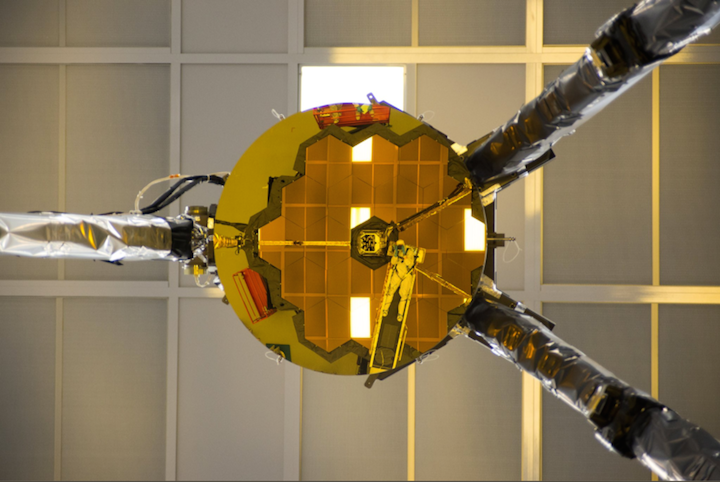
During Webb’s extensive cryogenic testing, engineers checked the alignment of all the telescope optics and demonstrated the individual primary mirror segments can be properly aligned to each other and to the rest of the system. This all occurred in test conditions that simulated the space environment where Webb will operate, and where it will collect data of never-before-observed portions of the universe. Verifying the optics as a system is a very important step that will ensure the telescope will work correctly in space.
The actual test of the optics involved a piece of support equipment called the ASPA, a nested acronym that means “AOS Source Plate Assembly.” The ASPA is a piece of hardware that sits atop Webb’s Aft Optics Subsystem (AOS), which is recognizable as a black “nose cone” that protrudes from the center of Webb’s primary mirror. The AOS contains the telescope’s tertiary and fine-steering mirrors. The ASPA is ground test hardware, and it will be removed from the telescope before it is launched into space.
During testing, the ASPA fed laser light of various infrared wavelengths into and out of the telescope, thus acting like a source of artificial stars. In the first part of the optical test, called the “half-pass” test, the ASPA fed laser light straight into the AOS, where it was directed by the tertiary and fine-steering mirrors to Webb’s science instruments, which sit in a compartment directly behind the giant primary mirror. This test let engineers make measurements of the optics inside the AOS, and how the optics interacted with the science instruments. Critically, the test verified the tertiary mirror, which is immovable, was correctly aligned to the instruments.
In another part of the test, called the “pass-and-a-half” test, light traveled in a reverse path through the telescope optics. The light was again fed into the system from the ASPA, but upwards, to the secondary mirror. The secondary mirror then reflected the light down to the primary mirror, which sent it back up to the top of Chamber A. Mirrors at the top of the chamber sent the light back down again, where it followed its normal path through the telescope to the instruments. This verified not only the alignment of the primary mirror itself but also the alignment of the whole telescope — the primary mirror, secondary mirror, and the tertiary and fine-steering mirrors inside the AOS.
Taken together, the half-pass and pass-and-a-half tests demonstrated all the telescope optics are properly aligned and that they can be aligned again after being deployed in space.
The photo, snapped by Ball Aerospace optical engineer Larkin Carey after the final fiber optic connections between ASPA and the laser source outside the chamber were made, verified the line of sight for the pass-and-a-half part of the test. The image was compared with one collected once the telescope was cold inside the chamber, to ensure any observed obscurations were due to the ASPA hardware and would not be present during science data collection on orbit.
In the photo, Carey is harnessed to a “diving board” over the primary mirror. All tools (including the camera) were tethered, and all safety protocol for working over the mirror were closely followed. Carey faced upwards and took the photo of the secondary mirror to verify the ASPA line of sight. The secondary mirror is reflecting him as well as the AOS, the ASPA, and the primary mirror below.
“Intricate equipment is required to test an instrument as complex as the Webb telescope. The ASPA allowed us to directly test key alignments to ensure the telescope is working as we expect, but its location meant we had to have a person install over 100 fiber optic cables by hand over the primary mirror,” said Allison Barto, Webb telescope program manager at Ball Aerospace. “This challenging task, which Larkin rehearsed many times to ensure it could be performed safely, also offered the opportunity to check the alignments by taking this ‘selfie’ prior to entering the test.”
After cryogenic testing at Johnson is complete, Webb’s combined science instruments and optics journey to Northrop Grumman in Redondo Beach, California, where they will be integrated with the spacecraft element, which is the combined sunshield and spacecraft bus. Together, the pieces form the complete James Webb Space Telescope observatory. Once fully integrated, the entire observatory will undergo more tests during what is called "observatory-level testing." This testing is the last exposure to a simulated launch environment before flight and deployment testing on the whole observatory.
Webb is expected to launch from Kourou, French Guiana, in the spring of 2019.
The James Webb Space Telescope, the scientific complement to NASA's Hubble Space Telescope, will be the premier space observatory of the next decade. Webb is an international project led by NASA with its partners, ESA (European Space Agency) and CSA (Canadian Space Agency).
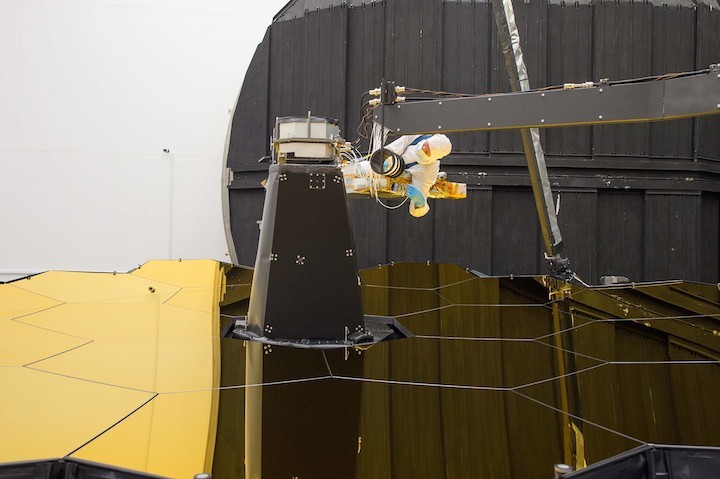
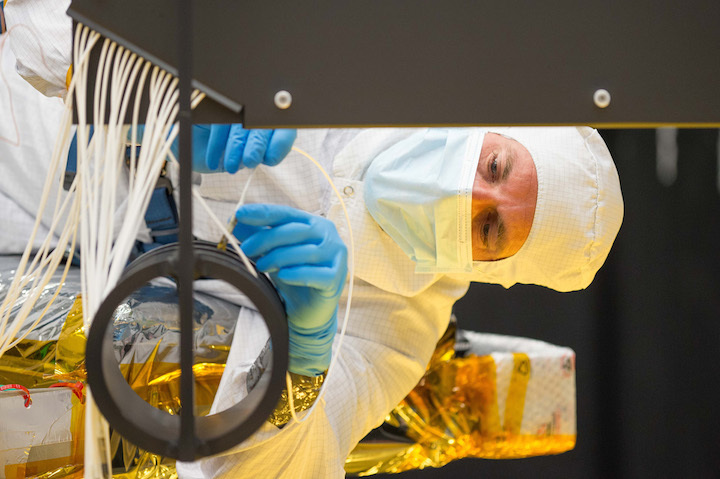
Sunshield Deployment and Layers Fully Tensioned on NASA’s James Webb Space Telescope
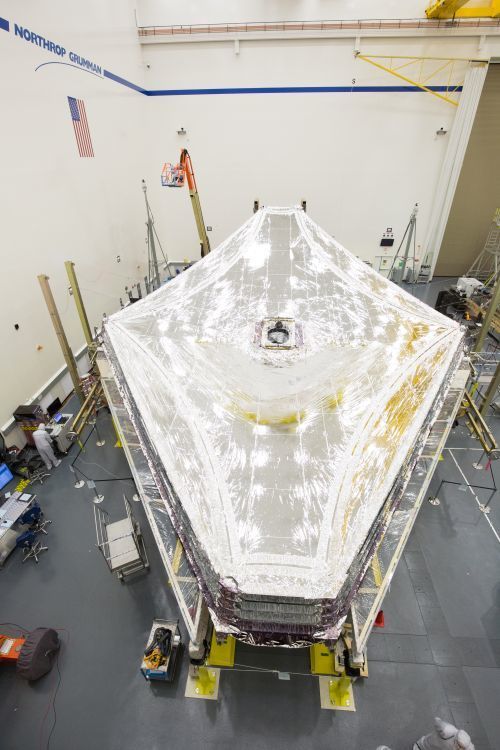
At Northrop Grumman highbay facilities in Redondo Beach, California, NASA’s James Webb Space Telescope’s five sunshield layers are fully tensioned for the first time.
-
REDONDO BEACH, Calif. – Oct. 26, 2017 – Northrop Grumman Corporation (NYSE: NOC), which designed NASA’s James Webb Space Telescope’s (JWST) optics, spacecraft bus, and sunshield for NASA Goddard Space Flight Center, has deployed the sunshield subsystem and fully tensioned the five sunshield layers for the first time.
“The first tensioning of the sunshield is a monumental and exciting moment, not only for the program but for the collaborative JWST team,” said Scott Willoughby, vice president and program manager, James Webb Space Telescope, Northrop Grumman Aerospace Systems “The innovative sunshield is an industry first, and will protect Webb’s optics from heat, making it possible to gather images of the formation of the first stars and galaxies more than 13.5 billion years ago.”
In space, the sunshield subsystem divides the JWST observatory into a warm sun-facing side and a cold space-facing side comprised of the optics and scientific instruments. The sunshield subsystem, which includes the structure and mechanisms required for deploying the five-layer subsystem, was designed, manufactured and assembled by Northrop Grumman, with the five membrane layers manufactured by the NeXolve Corporation in Huntsville, Alabama.
The flight membranes will be folded, stowed and tensioned again two additional times for testing. The folding and stowing method is how the membranes will be folded and stowed for launch. The sunshield layers, known for being the size of a tennis court, will protect and prevent the background heat from the Sun, Earth and Moon from interfering with JWST’s infrared sensors.
The sunshield layers, each as thin as a human hair, work together to reduce the temperatures between the hot and cold sides of the observatory by approximately 570 degrees Fahrenheit. Moving from the sun-facing layer to the one closest to the telescope, each successive layer of the sunshield, which is made of Kapton, is cooler than the one below. The sunshield, along with the rest of the spacecraft, will fold origami-style into an Ariane 5 rocket.
The James Webb Space Telescope, the scientific complement to NASA's Hubble Space Telescope, will be the premier space observatory of the next decade. Webb is an international project led by NASA with its partners, the European Space Agency and the Canadian Space Agency.
Quelle: Northrop Grumman
+++
About 1 million miles away from the nearest eye surgeon, NASA’s James Webb Space Telescope will be able to perfect its own vision while in orbit.
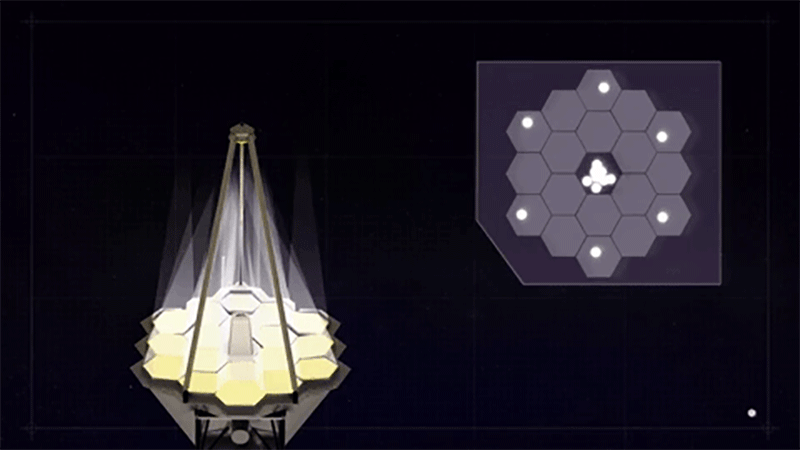
Though the Webb telescope will focus on stars and galaxies approximately 13.5 billion light-years away, its sight goes through a similar process as you would if you underwent laser vision correction surgery to be able to focus on an object 10 feet across the room. In orbit at Earth’s second Lagrange point (L2), far from the help of a terrestrial doctor, Webb will use its near-infrared camera (NIRCam) instrument to help align its primary mirror segments about 40 days after launch, once they have unfolded from their unaligned stowed position and cooled to their operating temperatures.
Laser vision correction surgery reshapes the cornea of the eye to remove imperfections that cause vision problems like nearsightedness. The cornea is the surface of the eye; it helps focus rays of light on the retina at the back of the eye, and though it appears to be uniform and smooth, it can be misshapen and pockmarked with dents, dimples, and other imperfections that can affect a person’s sight. The relative positioning of Webb’s primary mirror segments after launch will be the equivalent of these corneal imperfections, and engineers on Earth will need to make corrections to the mirrors’ positions to bring them into alignment, ensuring they will produce sharp, focused images.
These corrections are made through a process called wavefront sensing and control, which aligns the mirrors to within tens of nanometers. During this process, a wavefront sensor (NIRCam in this case) measures any imperfections in the alignment of the mirror segments that prevent them from acting like a single, 6.5-meter (21.3-foot) mirror. An eye surgeon performing wavefront-guided laser vision correction surgery (a process that was improved by technology developed to shape Webb’s mirrors) similarly measures and three-dimensionally maps any inconsistencies in the cornea. The system feeds this data to a laser, the surgeon customizes the procedure for the individual, and the laser then reshapes and resurfaces the cornea according to that procedure.
Engineers on Earth will not use a laser to melt and reshape Webb’s mirrors (feel free to give a sigh of relief); instead, they will use NIRCam to take images to determine how much they need to adjust each of the telescope’s 18 primary mirror segments. They can adjust the mirror segments through extremely minute movements of each segment’s seven actuators (tiny mechanical motors) — in steps of about 1/10,000th the diameter of a human hair.
The wavefront sensing and control process is broken into two parts — coarse phasing and fine phasing.
During coarse phasing, engineers point the telescope toward a bright star and use NIRCam to find any large offsets between the mirror segments (though “large” is relative, and in this case it means mere millimeters). NIRCam has a special filter wheel that can select, or filter, specific optical elements that are used during the coarse phasing process. While Webb looks at the bright star, grisms in the filter wheel will spread the white light of the star out on a detector. Grisms, also called grating prisms, are used to separate light of different wavelengths. To an observer, these different wavelengths appear as parallel line segments on a detector.
“The light from each segment will interfere with adjacent segments, and if the segments are not aligned to better than a wavelength of light, that interference shows up like barber pole patterns,” explained Lee Feinberg, optical telescope element manager for the Webb telescope at NASA’s Goddard Space Flight Center in Greenbelt, Maryland. “The analysis of the barber pole patterns tell the engineers how to move the mirrors.”
During fine phasing, engineers will again focus the telescope on a bright star. This time, they will use NIRCam to take 18 out-of-focus images of that star — one from each mirror segment. The engineers then use computer algorithms to determine the overall shape of the primary mirror from those individual images, and to determine how they must move the mirrors to align them. These algorithms were previously tested and verified on a 1/6th scale model of Webb’s optics, and the real telescope experienced this process inside the cryogenic, airless environment of Chamber A at NASA’s Johnson Space Center in Houston. Engineers will go through multiple fine-phasing sessions until those 18 separate, out-of-focus images become a single, clear image.
After the engineers align the primary mirror segments, they must align the secondary mirror to the primary, then align both the primary and secondary mirrors to the tertiary mirror and the science instruments. Though the engineers complete the initial alignment with NIRCam, Feinberg explained they also test the alignment with Webb’s other instruments to ensure the telescope is aligned “over the full field.”
The entire alignment process is expected to take several months, and once Webb begins making observations, its mirrors will need to be checked every few days to ensure they are still aligned — just as someone who underwent laser vision correction surgery will schedule regular eye doctor visits to make sure their vision is not degrading.
The James Webb Space Telescope, the scientific complement to NASA's Hubble Space Telescope, will be the premier space observatory of the next decade. Webb is an international project led by NASA with its partners, ESA (European Space Agency) and CSA (Canadian Space Agency).
Quelle: NASA
---
Update: 31.10.2017
.
More problems for big space telescopes
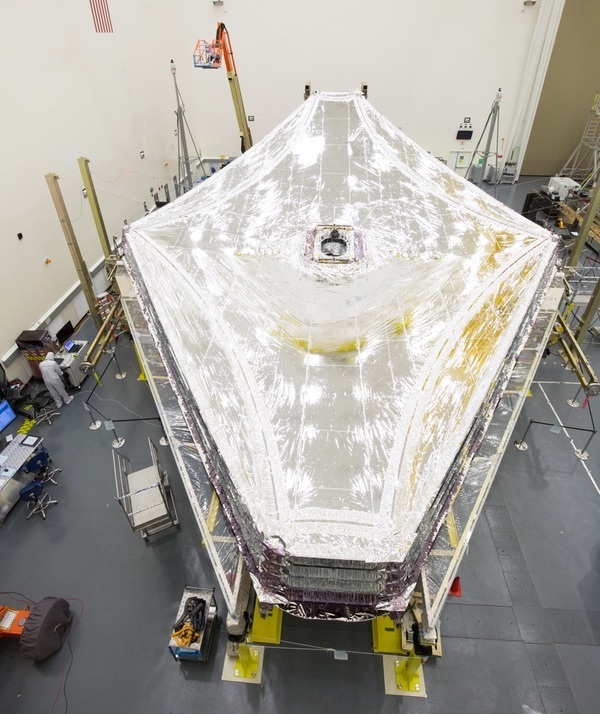
For the last few years, NASA had been championing the James Webb Space Telescope as a success story. Threatened with cancellation several years ago because of delays and cost overruns, NASA has emphasized on repeated occasions that the “replan” after that near-death experience was working well. The program was on budget, the agency said, making steady progress towards a launch on an Ariane 5 in the fall of 2018.
Until a month ago, that is. In a September 28 statement, NASA announced that the launch of the flagship space telescope would be delayed by half a year or more. The launch, the agency said, was now scheduled for between March and June of 2019.
| “We have budget reserve at headquarters, so what we can use that money to do is essentially buy more time, and that’s what we’ve done,” Smith said. |
“The change in launch timing is not indicative of hardware or technical performance concerns,” Thomas Zurbuchen, associate administrator for NASA’s science mission directorate, said in a statement about the slip. “Rather, the integration of the various spacecraft elements is taking longer than expected.”
NASA cited in particular issues with the spacecraft bus and its sunshield, designed to keep the telescope and its instruments at the cryogenic temperatures required for their infrared observations.
“Webb’s spacecraft and sunshield are larger and more complex than most spacecraft,” said Eric Smith, the program director for JWST at NASA headquarters, in that statement. “The combination of some integration activities taking longer than initially planned, such as the installation of more than 100 sunshield membrane release devices, factoring in lessons learned from earlier testing, like longer time spans for vibration testing, has meant the integration and testing process is just taking longer.”
Smith and others faced questions at recent hearings by committees that advise NASA and the National Academies’ Space Studies Board on astrophysics issues. Among them was confusion by some astronomers how JWST, which previously had three and a half months of schedule margin, could slip its schedule by six months without affecting other programs, as NASA claimed.
Smith explained at a meeting of the Astrophysics Advisory Committee October 18 that the delay was funded by program reserves held at the headquarters level, separate from the project’s own reserves. “This delay is entirely funded by money in headquarters reserve,” he said.
He declined to disclose the size of that reserve. “We have budget reserve at headquarters, so what we can use that money to do is essentially buy more time, and that’s what we’ve done,” he said. That reserve, he added, would be largely expended on this delay.
In recent months, there was another issue that threatened to delay the launch. ESA’s BepiColombo mission to Mercury was, after its own series of delays, being prepared for a launch on an Ariane 5 at the same time as JWST: October 2018. Both missions couldn’t launch in the same month, and in fact, due to payload processing requirements, one would have to be prepared and launched before the other could begin processing at the French Guiana launch site. If BepiColombo won priority over JWST, it meant delaying JWST until early 2019 at the earliest.
However, Smith said that BepiColombo had no role in the delay. “In the end, it turned out to be completely unrelated,” he said. NASA owed ESA, which in turn owed launch provider Arianespace, one year’s notice for JWST’s launch. By late September, though, it was clear the telescope would not be ready for a fall 2018 launch. “It didn’t matter that Bepi was there. We needed to move for our own purposes.”
| “Fundamentally, approximately a year from launch it seems you discovered you needed another six months,” Young said. “That doesn’t say much for how well the program was being managed.” |
Smith said that there’s no specific launch readiness date yet for JWST beyond the March-June window, in part as NASA and prime contractor Northrop Grumman work on the sunshade and spacecraft bus issues, including a separate problem with thruster valves that need to be replaced.
At an October 24 meeting of the Space Studies Board’s Committee on Astronomy and Astrophysics, Smith gave a similar overview of the status of JWST, but faced sharper criticism from one committee member, Thomas Young, a former aerospace executive and NASA center director known for often blunt assessments.
“Fundamentally, approximately a year from launch it seems you discovered you needed another six months,” Young said. “That doesn’t say much for how well the program was being managed.”
Smith said schedule estimates for activities in this phase of assembly and testing of JWST “were found to be pretty optimistic.” He suggested there were issues at Northrop Grumman. “The person who was the integration and test lead at Northrop has new work now,” he said.
Young persisted in his questioning, arguing that NASA should have had more oversight into this to catch the delays sooner. Smith agreed. “We should have been more conservative from the start on this schedule,” he said.
“Realistic, maybe,” Young interjected.
The updated schedule, Smith, said has “more realism” into its estimates. “This is much harder than I would have expected.”
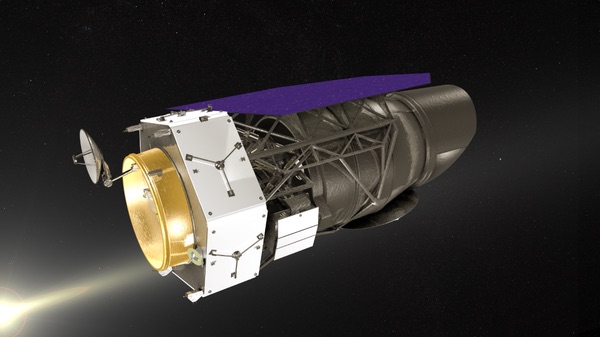
Illustration of the planned WFIRST spacecraft, which will undergo a review in order to cut costs, at the expense of some science. (credit: NASA)
|
Long before JWST’s latest problems, NASA was already working to apply the lessons learned from it on its next large astrophysics mission, the Wide Field Infrared Survey Telescope, or WFIRST. While WFIRST won’t be as large as JWST—its primary mirror, one of two donated to NASA by the National Reconnaissance Office five years ago, is 2.4 meters across—it will be NASA’s largest astrophysics mission since JWST with a budget in the billions of dollars.
After a National Academies committee, reviewing progress on the implementation of the latest astrophysics decadal survey, warned last year that budget growth in WFIRST could threaten NASA’s overall balance of programs, the agency established an independent review team for the mission before allowing it to pass a milestone known as Key Decision Point B.
| “The bottom line is that the current scope and complexity don’t fit with the anticipated available funds,” said Michelson. |
That report by the WFIRST Independent External Technical/Management/Cost Review (WIETR), delivered to NASA earlier this month, has yet to be released by the agency, but was critical enough that it warranted changes to the program. In an October 19 letter, Zurbuchen directed NASA’s Goddard Space Flight Center, where WFIRST is based, to redesign elements of the mission to lower its cost.
“The WFIRST project’s latest life cycle cost estimate for the mission of $3.6B (as compared to the earlier [estimate] of $3.2B) was validated by the independent review team,” he wrote. “I am directing the Goddard Space Flight Center to study modifying the current WFIRST design, the design that was reviewed by the WIETR, to reduce cost and complexity sufficient to have a cost estimate consistent with the $3.2B cost target set at the beginning of Phase A.”
Those cuts would come from unspecified “reductions” in a wide-field camera that is one of the mission’s primary instruments, as well as a separate coronagraph instrument that would also be treated as a “technology demonstration” because of the risks posed by its advanced technology.
Other elements of WFIRST, including its use of the NRO-donated mirror, would be unaffected by the change, for now. However, Zurbuchen warned that if this effort, to be completed by early next year, could not meet the new cost target, “I will direct a follow-on study of a WFIRST mission consistent with the architecture described by the Decadal Survey.” That original architecture called for the use of a much smaller mirror, 1.5 meters across or smaller.
NASA has yet to release the report, but the co-chairs of the WIETR panel briefed the Committee on Astronomy and Astrophysics about their study October 25. “The bottom line is that the current scope and complexity don’t fit with the anticipated available funds,” said Peter Michelson, one of the co-chairs.
That briefing revealed that the $3.6 billion cost estimate for WFIRST currently is at the 50-percent confidence level; that is, there is only a 50-percent chance that the mission would cost no more than that. Moving to the 70-percent confidence level, typically used for NASA missions once in a later phase of development, increased the cost estimate to more than $3.9 billion.
Some committee members dismissed the lower cost estimate. “A 50-percent confidence, in NASA’s experience, is not an executable program,” said Tom Young. “The most probable outcome is the 70-percent number.” Orlando Figueroa, the other WIETR co-chair, agreed, calling the 50-percent number “not adequate.”
Further complicating the cost estimate is a desire to address the level of risk for the mission. The report noted that NASA considered WFIRST a “Class B” mission in its categorization of risk, making it not nearly as rigorous than Class A missions, to which large missions like WFIRST are typically assigned. The review found that moving WFIRST to the Class A category could cost an additional $300 million or so.
“So you’re really recommending, if the requirements stay as they are, you’re saying this should be budgeted at $4.2 billion,” Young said.
NASA’s direction to the mission team, however, is to bring the cost down to $3.2 billion at that 50-percent level, while also increasing the risk posture of WFIRST to be “compatible” with a Class A mission. That will require some sacrifices, the agency acknowledges.
“You can’t do this without losing some science,” said Paul Hertz, director of NASA’s astrophysics division. “So the WFIRST that the team brings forward in the February timeframe is going to incorporate science reductions from the one baselined now.” That will still be well above the recommendations of the decadal survey, he added. “It continues to make this a mission which is deserving of our implementation as a strategic mission in the astrophysics program.”
| “You can’t do this without losing some science,” said Hertz. “So the WFIRST that the team brings forward in the February timeframe is going to incorporate science reductions from the one baselined now.” |
He also defended a decision not to release the WIETR report immediately. “The WIETR report has a lot of details in it, a lot of options that the panel laid out as possibilities for the team,” he said. “We want to give the project some space to make choices and come forward with a modified design without being second-guessed all the time in public.” Zurbuchen said that the report will be released next February, when the revised spacecraft design is due.
Despite the concerns about potential increasing costs, there are signs that NASA is applying the lessons learned from JWST on WFIRST. The concerns about costs and immature technologies—including not just the coronagraph but proposals to make the observatory compatible with a future starshade—are being addressed early in the mission, while still in Phase A, and not later, when problems would be more difficult, expensive, and time-consuming to address.
The WIETR co-chairs, at the committee meeting, praised the project for the progress it has made. “There has been a significant investment to date on this mission, on the order of $300 million,” said Figueroa. “It is very mature for where they are in Phase A.” It has, though, a long way to go.
Quelle: The Space Review
---
Update: 13.11.2017
.
NASA's James Webb Space Telescope Early Science Observations Revealed
Astronomers around the world will have immediate access to early data from specific science observations from NASA’s James Webb Space Telescope, which will be completed within the first five months of Webb’s science operations. These observing programs were chosen from a Space Telescope Science Institute call for early release science proposals, and include examining Jupiter and its moons, searching for organic molecules forming around infant stars, weighing supermassive black holes lurking in galactic cores, and hunting for baby galaxies born in the early universe.
“I’m thrilled to see the list of astronomers’ most fascinating targets for the Webb telescope, and extremely eager to see the results. We fully expect to be surprised by what we find," said Dr. John C. Mather, Senior Project Scientist for the Webb telescope and Senior Astrophysicist at NASA’s Goddard Space Flight Center, Greenbelt, Maryland.
The resulting observations will comprise the Director’s Discretionary Early Release Science (DD-ERS), and cover the gamut of Webb science targets, from planets in our solar system to the most distant galaxies. The program provides the entire scientific community with immediate access to Webb data so they have the opportunity to analyze the data and plan follow-up observations.
“We were impressed by the high quality of the proposals received,” said Dr. Ken Sembach, Director of the Space Telescope Science Institute (STScI) in Baltimore, Maryland. “These observing programs not only will generate great science, but also will be a unique resource for demonstrating the investigative capabilities of this extraordinary observatory to the worldwide scientific community.”
The observations will also exercise all four of Webb’s science instruments, so that the astronomical community can explore Webb’s full potential. Webb has a minimum scientific lifetime of five years, so the scientific community will have to rapidly learn to use its advanced capabilities.
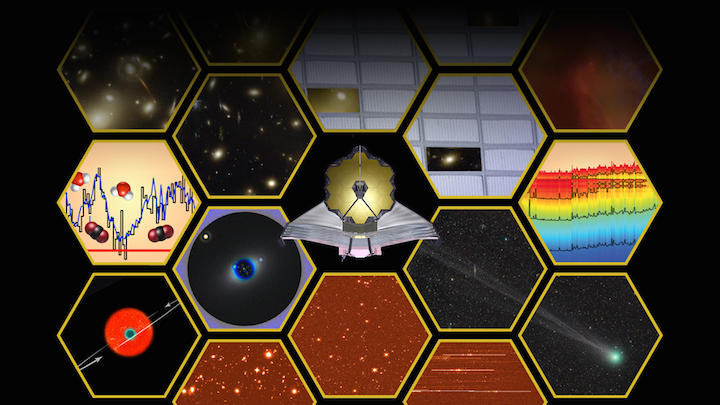
“We want the research community to be as scientifically productive as possible, as early as possible, which is why I am so pleased to be able to dedicate nearly 500 hours of director’s discretionary time to these ERS observations,” said Sembach.
One of the most widely anticipated areas of research by Webb is to study planets orbiting other stars. When such an exoplanet passes in front of its host star, starlight filters through the planet’s atmosphere, which absorbs certain colors of light depending on the chemical composition. Webb will measure this absorption, using its powerful infrared spectrographs, to look for the chemical fingerprints of the atmosphere’s gasses. Astronomers initially will train their gaze onto gaseous Jupiter-sized worlds like WASP-39b and WASP-43b because they are easier targets on which to apply this technique. The results will help guide observing strategies for smaller, mostly rocky and more Earth-like super-Earths, where atmospheric composition may give hints of a planet’s potential habitability.
Webb also will peer into the distant universe, examining galaxies whose light has been stretched into infrared wavelengths by the expansion of space. This infrared region is beyond what Hubble can detect. Galaxy clusters are particularly rich sources of targets, since a cluster’s gravity can magnify light from more distant background galaxies. DD-ERS observations will target regions of the sky already examined by Hubble’s Frontier Fields program, such as the galaxy cluster MACS J0717.5+3745. Webb data will complement Hubble’s, giving astronomers new insights into these cornucopias of galaxies.
Since Webb must remain shielded from sunlight, its field of view is limited to specific areas of the sky at certain times of year. As a result, the potential targets listed above may shift depending on the launch date.
More than 100 proposals for DD-ERS observations were submitted in August 2017. Of those, 13 programs requesting 460 hours of telescope time were selected following review by panels of subject matter experts and the STScI director.
Quelle: NASA


